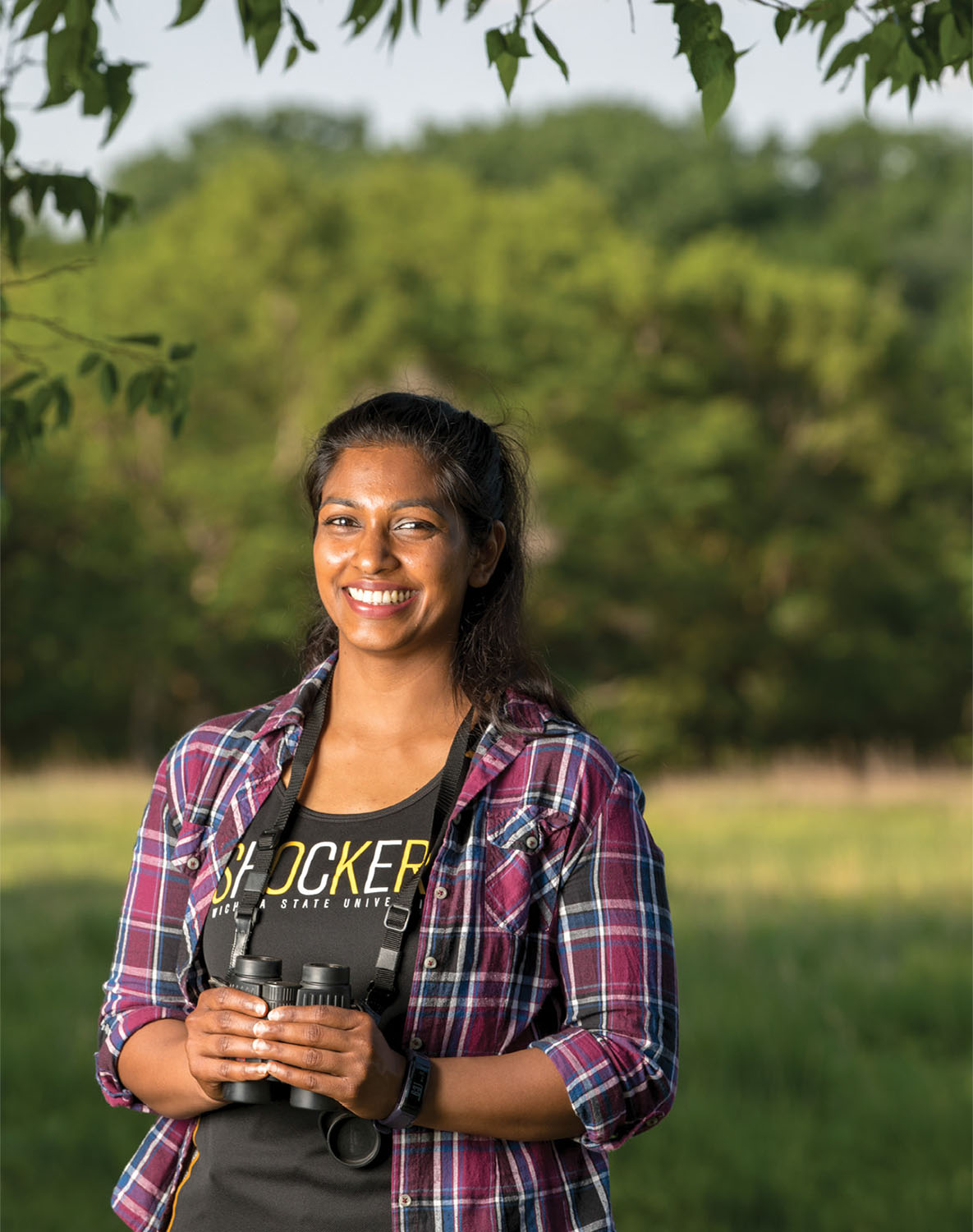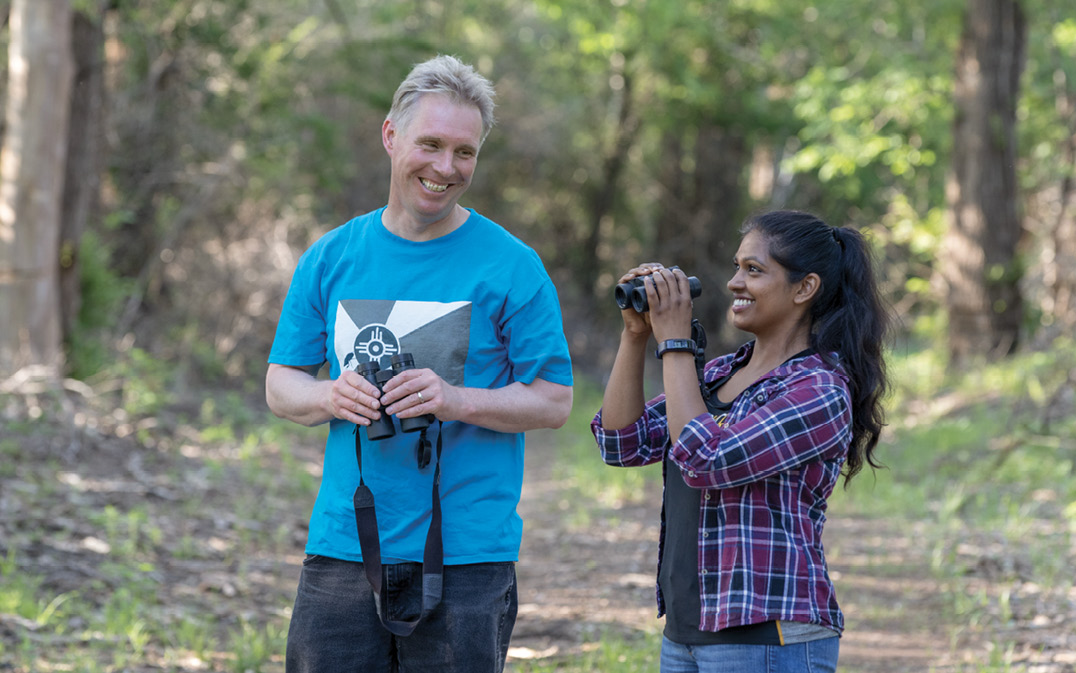Wichita State’s Biological Field Station and Ninnescah Reserve is located some 35 miles southwest of the university’s main campus. With acreage that hugs the southern bank of the Ninnescah River, the field station and reserve offer unique opportunities for the study of grassland restoration, river ecology, and general wildlife biology. Among current investigations are prairie recovery from overgrazing, plant-insect interactions – and Nuwanthika Perera’s look into the vocal communication calls of dark-eyed juncos and American tree sparrows.

It’s last winter, on the Ninnescah Reserve southwest of Wichita. The reserve houses the WSU Biological Field Station, and Nuwanthika “Nu” Perera ’17 is huddled inside a camouflaged blind, counting the birds in a small flock lured by the seeds she has scattered over the brown grass, barely visible beneath a dusting of snow. Nearby, a microphone setup records the proceedings.
The data Perera’s gathering is intended to answer a minor ornithological mystery. The two migratory bird species she’s studying for her graduate thesis – the American tree sparrow, Spizelloides arborea, and the dark-eyed junco, Junco hyemalis – have similar habitats, similar diets, similar predators, including the Cooper’s hawk. And yet, while the junco in winter is a rotund little bird, with ample fat reserves to get it through lean times, the tree sparrow’s fat levels are lower.
Why?
Leland Russell, an associate professor in biological sciences at Wichita State, and Nuwanthika Perera ’17, who will be a doctoral student this fall at the University of Oklahoma, revisit the area of Perera’s thesis research on American tree sparrows and dark-eyed juncos.
Perera’s thesis, “Possible relationship between vocal communication system and fat reserve in wintering birds:
A test of the optimal body mass theory,” explores whether the birds’ calls might hold the answer.
“Communication is very important when there are predators around,” she explains. “It’s like, ‘You should go hide because there’s a predator coming to eat you!’ If someone tells you that, then you can hide yourself.” She hypothesized that the juncos have more call types than the sparrows – that they use more “words,” in a sense – and that this greater vocabulary allows them to communicate more efficiently, boosting their ability to warn one another of danger. This resultant higher level of safety for the juncos might equate to more time to chow down and put on winter weight.
To investigate this theory, Perera recorded and analyzed hours of the calls of these two bird species, and measured their body fat levels by holding them in her hand and gently blowing their stomach feathers aside, revealing a visible layer of fat under the skin. Although she didn’t get the definitive answers she’d hoped for, her results proved interesting – and surprising.
Perera’s interest in ornithology began 9,000 miles away, in her home country of Sri Lanka. She grew up in a rural area, where, she says, “my brightest memory from childhood was watching insects, birds, and butterflies in my home garden.” This love of animals led her to study zoology as an undergraduate at the University of Peradeniya, where she’d begun work on a senior project on zooplankton – tiny organisms that populate the waters of the world –
before realizing her choice of research activity didn’t suit her personality at all.
“I had to sit inside a lot, and looking through the microscope, it did not fit me, I didn’t like it,” she recalls. “I got totally bored with that.” When she complained to a teaching assistant friend, he pointed out that she accompanied him on birding expeditions frequently and seemed to enjoy the outdoor excursions – why not do her project on birds?
So instead of hunching over a microscope, she observed the foraging behavior of two different species of sunbird with different beak lengths; she learned that, as the birds foraged for nectar, “they don’t care about the color of the flower … or the concentration of the nectar, they just (care) about the corona length” of the flower. The longer-beaked species was able to sip from any flower, no matter how deep, while the short-beaked one was limited to what it could reach.
While researching for that project, Perera says, she encountered articles by Chris Rogers, WSU’s longtime avian biologist now retired. It was Perera’s interest in his work that drew her to Wichita State. (For more about
Rogers and his research on birds, search The Shocker archives at theshockermagazine.com for “Cardinal Virtues,” 2004, “Stops Along the Way,” 2007, and “Notes on Snowy Egrets,” 2013.) Building on Rogers’ studies, as well as those of Ellen Ketterson at Indiana University, Perera took on the junco-sparrow communication project.
Leland Russell, who took over as Perera’s thesis advisor after Rogers retired, also serves as graduate coordinator for WSU’s biology department. He remembers that when she applied to graduate school he was impressed with her, especially with how “the breadth and diversity of coursework she had in zoology was something I’d never seen before.” During her thesis work, Russell adds, she “dealt with adversity very
well” – her first winter at Ninnescah, one of the two species she’d planned to study didn’t show up! She persisted nonetheless. And what she discovered was unexpected.
As she’d predicted, the fatter juncos used more call types, from a high, clicking twit while flying to an aggressive kew used to chase rivals away from food. The sparrows, Perera found, used one call more often than the juncos used their corresponding call – and “that one call type was their alarm call.”
Thus, not only was the tree sparrow communication less varied, they were saying the same thing over and over: “Predator! Run away!” They said it so often, in fact, that Perera realized they weren’t telling the other sparrows the truth; instead, they were chasing away the competition for food by warning of nonexistent predators. In other words? American tree sparrows are liars.
Perera is off to the University of Oklahoma this fall, where she’s planning to keep studying winter birds, exploring how their habitats are affected by weather patterns and by climate change – already a factor in her research, since the winters of 2015-16 and 2016-17 had much lower snowfall than average.
She’d like to stay in academia, so she’ll be able to teach while doing research. Someday, she’d love to go back to Sri Lanka to study. After all, she says, “they have rainforest, and there are a lot of species they haven’t studied at all.”
Wherever she ends up, it won’t be stuck indoors over a microscope: she’ll be outside with the birds.
Liar, Liar, Feathers on Fire
Oh, the things one can learn out in the field at Wichita State’s Biological Field Station and Ninnescah Reserve!
By Connie Kachel White
A network of distinct properties, the field station and reserve share these four mission areas: research, teaching, conservation and public outreach. Beginning with the acquisition of the Ninnescah Reserve itself in 1984, the field station has grown to include the Gerber and Sellers Reserves, the Youngmeyer Ranch Reserve and, completed in 2010, the WSU Biological Field Station Building.
The rich and varied resources of these reserves offer unique opportunities to study grassland restoration, river ecology, and general wildlife biology. Some of the recent and ongoing investigations target prairie restoration and recovery from overgrazing, plant-insect interactions, the ecology of aquatic invertebrates, fitness maximization of birds in the non-breeding season, monitoring riparian and prairie bird nesting communities, stopover ecology of long distance Neotropical avian migrants, incidence of West Nile virus in birds, and monitoring of fish, amphibians and reptiles, and mammal population dynamics. In addition to Wichita State activities, including those of Nuwanthika Perera ’17, the field station has also been used for research and teaching efforts of 11 universities and several local high schools.
In all the research activities to date, though, Perera has been the only one to come away with the surprising results that one of her research subjects might just be a born liar. But which one?
The dark-eyed junco is a songbird in the family of sparrows. Juncos, which forage for food mostly while hopping and running on the ground, are often called the “snowbirds” of middle latitudes because they show up over most of the eastern United States as winter sets in and then retreat northward each spring. The American tree sparrow, which despite its name isn’t particularly associated with trees, is also known as the winter sparrow. Common in open country, they generally forage on the ground or in low bushes and migrate relatively late in fall and early in spring. Both the dark-eyed junco and the tree sparrow build nests on the ground at northern latitudes, and both are common winter visitors to Wichita State’s field station, where Perera set out feeding stations for them – and where, after recording and analyzing their vocal communication calls, she discovered that the tree sparrows kept warning one another, over and over again, that a predator was near, even when one was not.
The tree sparrows, Perera concluded, were trying to scare off competitors for food – by lying!






